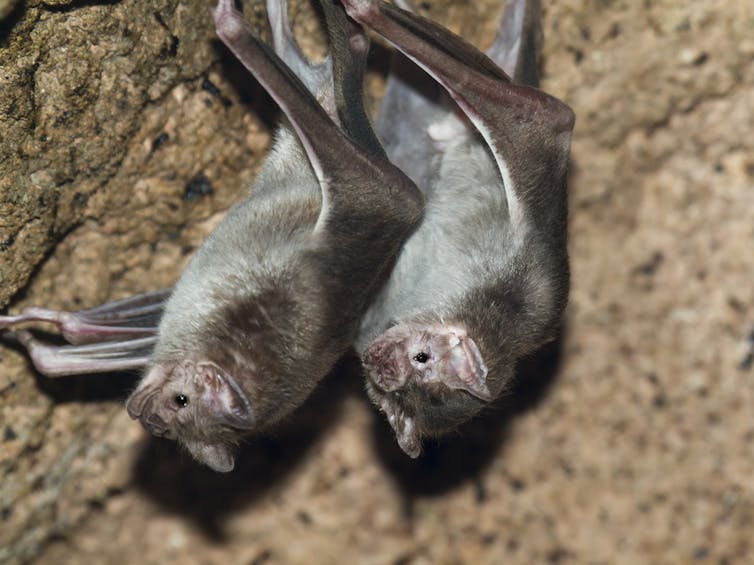Comment | Vampire bats aren't the monsters we thought they were

Jan Hoole, Lecturer in Biology, Keele University writes for The Conversation.
The closest you’ve ever come to a vampire bat may be a Halloween decoration. But in South America, vampire bats are less feared for their association with Dracula and more for their ability to carry and transmit rabies. They also feed on the blood of domestic animals such as horses, donkeys, cattle and even humans. No wonder they’re not popular with farmers, but you might be surprised to learn they form stable, long-term relationships, which appear to resemble human friendships.
A new paper published in Current Biology found that 23 female common vampire bats (Desmodus rotundus) formed close roosting, grooming and feeding partnerships while kept in captivity for 22 months. Once released into the wild, they kept up the habit and stayed in touch.
This was slightly unexpected – such relationships usually deteriorate in wild animals once their physical environment is suddenly changed, but the researchers found that the 23 bats preferred to groom, feed and be fed by the buddies they had made in captivity.
So this parasitic creature of the night is more of a softie than you might think. But that’s not all – vampire bats are among the most misunderstood creatures in the animal kingdom and it’s time to set the record straight.
Out of the crypt and into our hearts?
Vampire bats are found in many parts of South and Central America and all three species are nocturnal. Like the mythical creatures they’re named for, they feed entirely on the blood of other animals.
A vampire bat’s incisor teeth are razor sharp and they’re used to cut a small groove or crater in the skin of the host animal.
The bat then dribbles saliva into the wound, which prevents the blood from clotting. Grooves on the underside of the tongue line up with a groove in the lower lip to form a kind of drinking straw for the blood to flow through. But when the bat has finished feeding, the anti-coagulant in its saliva means that blood will continue to flow from the bite wound for some time, which can seriously weaken the host animal.
So far, so creepy. But what you probably didn’t know is that vampire bats are among the few non-human animals known to show altruism. If a vampire bat doesn’t feed for several days it will die of starvation. Fortunately, a bat in this predicament can get by with a little help from its friends.
A starving bat will go to her roost mates during the day and beg for food and they’ll often oblige by regurgitating some of the blood they drank during the previous night. In this way, each bat loses a portion of their own food, but the bat who hasn’t fed survives.
Of course, there is no such thing as a free lunch and it’s expected that, when one of the bats who has given food is herself hungry, the bat she has fed will return the favour. Those who fail to reciprocate will not be fed on future occasions.
In order to be sure that you aren’t giving out food and receiving nothing in return, it’s necessary to remember who you have fed and who has fed you. This means bats must remember the face, voice or smell of each of the bats they associate with. That’s how this species finds and remembers the friends they share food with.
Those bats who share food also tend to groom each other. This is a social behaviour that helps to make and keep bonds between bats – it’s a bit like going for a coffee with a friend and having a good gossip.

Sadly, the researchers found that young female bats that were born in captivity weren’t accepted into the wild colony, even if their mother was. This is particularly poignant as mothers and daughters share the strongest bonds between bats.
The researchers suggested that growing up in captivity may prevent bats from developing the necessary social skills for living alongside their own kind in the wild, just as “fitting in” for humans demands being receptive to social cues and knowing how to make friends. The bite marks on rejected young females highlight the toll of marginalisation in bat society.
It seems that friendship bonds are just as important to bats as to humans, and probably for some of the same reasons. Familiarity equals safety – you don’t need to put yourself at risk by approaching a stranger who may be less than friendly, and if you play your cards right, you can strengthen the bond with your “friend” and make them more likely to help you in future.
All of a sudden, vampire bats sound a lot less like cold and scary monsters and a lot more like us. Perhaps that could make us look more kindly on these tiny and much maligned creatures.![]()
Jan Hoole, Lecturer in Biology, Keele University
This article is republished from The Conversation under a Creative Commons license. Read the original article.
Most read
Contact us
Andy Cain,
Media Relations Manager
+44 1782 733857
Abby Swift,
Senior Communications Officer
+44 1782 734925
Adam Blakeman,
Press Officer
+44 7775 033274
Ashleigh Williams,
Senior Internal Communications Officer
Strategic Communications and Brand news@keele.ac.uk.


